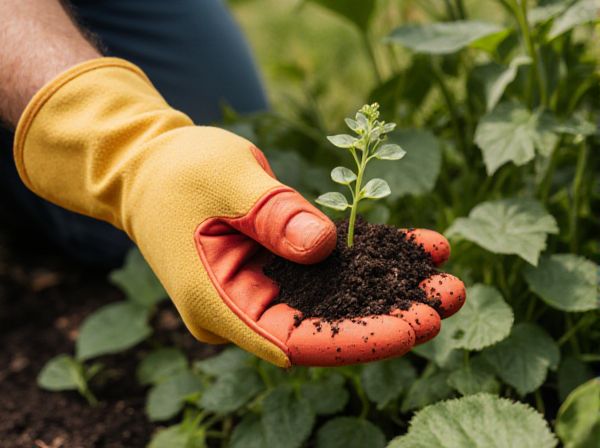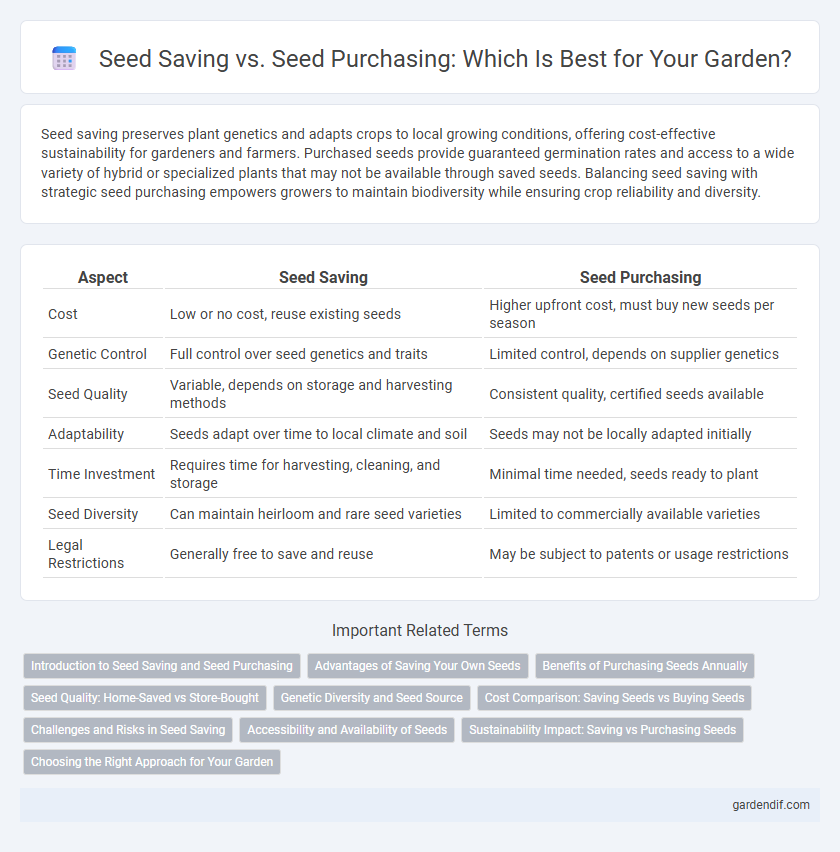
Seed saving vs Seed purchasing Illustration
Seed saving preserves plant genetics and adapts crops to local growing conditions, offering cost-effective sustainability for gardeners and farmers. Purchased seeds provide guaranteed germination rates and access to a wide variety of hybrid or specialized plants that may not be available through saved seeds. Balancing seed saving with strategic seed purchasing empowers growers to maintain biodiversity while ensuring crop reliability and diversity.
Table of Comparison
| Aspect | Seed Saving | Seed Purchasing |
|---|---|---|
| Cost | Low or no cost, reuse existing seeds | Higher upfront cost, must buy new seeds per season |
| Genetic Control | Full control over seed genetics and traits | Limited control, depends on supplier genetics |
| Seed Quality | Variable, depends on storage and harvesting methods | Consistent quality, certified seeds available |
| Adaptability | Seeds adapt over time to local climate and soil | Seeds may not be locally adapted initially |
| Time Investment | Requires time for harvesting, cleaning, and storage | Minimal time needed, seeds ready to plant |
| Seed Diversity | Can maintain heirloom and rare seed varieties | Limited to commercially available varieties |
| Legal Restrictions | Generally free to save and reuse | May be subject to patents or usage restrictions |
Introduction to Seed Saving and Seed Purchasing
Seed saving involves collecting and storing seeds from healthy, mature plants for future planting, promoting biodiversity and preserving heirloom varieties. Seed purchasing offers access to a wide range of hybrid and genetically enhanced seeds that ensure uniformity and high yield potential. Both practices play crucial roles in sustainable agriculture and food security by balancing genetic diversity with crop reliability.
Advantages of Saving Your Own Seeds
Saving your own seeds preserves genetic diversity and ensures plants are well-adapted to local growing conditions, boosting crop resilience and yield. It reduces costs by eliminating the need for purchasing new seeds each season, fostering greater self-sufficiency for gardeners and farmers. Home-saved seeds often retain heirloom varieties, supporting biodiversity and heritage cultivation practices.
Benefits of Purchasing Seeds Annually
Purchasing seeds annually ensures access to a wide variety of high-quality, disease-resistant, and genetically pure seeds that boost crop yields and uniformity. Certified commercial seeds often come with guarantees of germination rates and compliance with agricultural standards, reducing the risk of crop failure. Annual seed buying also provides farmers with the latest hybrid or engineered seed varieties optimized for specific climates and pests, enhancing overall agricultural productivity.
Seed Quality: Home-Saved vs Store-Bought
Home-saved seeds often retain superior genetic traits adapted to local growing conditions, resulting in higher seed quality and better crop performance. Store-bought seeds may be treated for uniformity and disease resistance but can lack the genetic diversity crucial for resilience in varying environments. Preserving local seed varieties through home-saving ensures ongoing access to high-quality seeds tailored to specific climates and soils.
Genetic Diversity and Seed Source
Preserving genetic diversity through seed saving maintains heirloom varieties adapted to local conditions, reducing reliance on commercial seed sources that often offer limited genetic variation. Seed purchasing frequently involves hybrid or genetically uniform seeds, which can decrease crop resilience and biodiversity over time. Emphasizing seed saving promotes sustainable agriculture by safeguarding diverse gene pools critical for future breeding and environmental adaptability.
Cost Comparison: Saving Seeds vs Buying Seeds
Saving seeds significantly reduces annual gardening expenses by eliminating the recurring cost of purchasing new seeds, which can range from $2 to $10 per packet depending on the plant variety. Over time, seed saving enhances cost-efficiency, especially for heirloom and organic seeds that tend to be more expensive in stores. Moreover, seed saving preserves genetic diversity and adapts plant strains to local conditions, indirectly contributing to long-term financial savings through improved crop resilience and yield.
Challenges and Risks in Seed Saving
Seed saving faces challenges such as genetic drift, which can reduce seed diversity and crop resilience over successive generations. Risks include seed contamination from cross-pollination and the potential loss of seed viability without proper storage conditions. These factors make seed saving more complex and less reliable compared to seed purchasing from commercial suppliers.
Accessibility and Availability of Seeds
Seed saving enhances accessibility by empowering gardeners to harvest and store seeds from their own crops, ensuring a steady supply tailored to local growing conditions. Seed purchasing offers immediate availability with a wide variety of cultivars from commercial suppliers, though it may involve higher costs and limited adaptation to specific regions. Relying on seed saving fosters biodiversity and reduces dependency on external sources, promoting sustainable agriculture and resilient food systems.
Sustainability Impact: Saving vs Purchasing Seeds
Saving seeds enhances agricultural sustainability by promoting local biodiversity, reducing dependence on commercial seed markets, and preserving heirloom varieties adapted to specific climates. Purchasing seeds often involves reliance on industrial agriculture, which can lead to genetic uniformity, increased carbon footprints from transportation, and vulnerability to market prices and corporate control. Seed saving supports resilient farming practices and long-term food security by maintaining genetic diversity and lowering environmental impacts.
Choosing the Right Approach for Your Garden
Seed saving preserves heirloom varieties and maintains genetic diversity, allowing gardeners to cultivate plants best suited to their local conditions. Seed purchasing offers access to a wide range of hybrid and specialty varieties with consistent germination rates and disease resistance. Balancing saved seeds with purchased seeds ensures a robust, resilient garden tailored to both personal preferences and environmental factors.
Seed saving vs Seed purchasing Infographic

 gardendif.com
gardendif.com